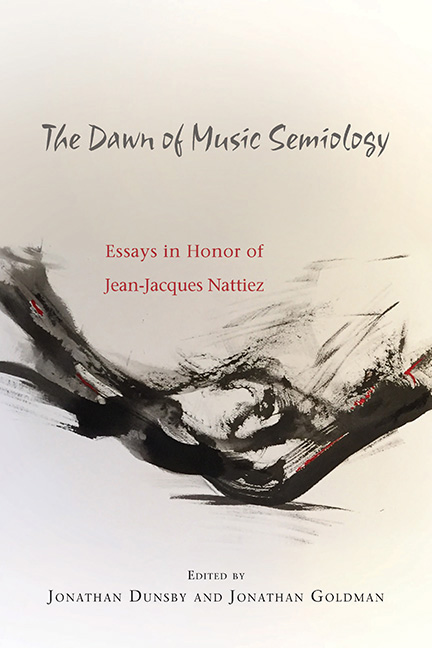Book contents
- Frontmatter
- Contents
- Foreword: About Jean-Jacques Nattiez
- Acknowledgments
- Introduction
- Part One Metaconsiderations
- 1 Music and Gesture
- 2 Music Semiology in the Mind of the Musician
- 3 Against Ethnotheory
- Part Two Poietic Channels
- Part Three Esthesic Excursions
- Selected Bibliography of Works by Jean-Jacques Nattiez
- List of Contributors
- Index
- Tabula Gratulatoria
1 - Music and Gesture
from Part One - Metaconsiderations
Published online by Cambridge University Press: 26 April 2018
- Frontmatter
- Contents
- Foreword: About Jean-Jacques Nattiez
- Acknowledgments
- Introduction
- Part One Metaconsiderations
- 1 Music and Gesture
- 2 Music Semiology in the Mind of the Musician
- 3 Against Ethnotheory
- Part Two Poietic Channels
- Part Three Esthesic Excursions
- Selected Bibliography of Works by Jean-Jacques Nattiez
- List of Contributors
- Index
- Tabula Gratulatoria
Summary
The Body and Music
It is obvious that gesture and the human body must be incorporated into music, but how do we do that? I think it would be both misleading and futile to somehow add gesture in with music, meaning adding it to music in the way this has been thought of since the age of Pythagoras, for about the last two and a half millennia. That would be to produce a chimera, a two-headed, impossible being created artificially on contradictory premises. To reintegrate gesture with music appropriately, we have to question existing definitions of the art of sound and reconstruct something in which the body takes its proper place from the start. That is no easy undertaking, since music always tends to be understood, without our reckoning on this, in terms of a duality in which the soul is at odds with the body, in which pure music, its autonomy intact, is at odds with all the external impurities that may be associated with it.
The history of Western music theory presents us with an uninterrupted series of dualisms for which the names may change or be swapped around but the logic of which remains the same: on the one hand, there is pure music, music from on high, ideal music; on the other hand, low, mundane, impure music. This distinction dates from the origins of Western civilization. Greek thought has always differentiated musical practice—in which poetry, dance, and sonic art are grouped because they have rhythm in common—from music theory, the science of harmony that arose at the same time as mathematics, philosophy, and theology: sociology on one side, resting on the interplay of trends and ethos, and on the other a science discovering the nature of things. Medieval music, following neo-Pythagorean and neo-Platonic ideas from antiquity, remodeled the duality on new fundamentals. The six-century Boethius, in De institutione musica contrasts musica mundana—heavenly music known through speculation in a quadrivium with arithmetic, geometry, and astronomy— with musica humana, the harmony of the body and the soul, and musica instrumentalis, produced by human agents.
- Type
- Chapter
- Information
- The Dawn of Music SemiologyEssays in Honor of Jean-Jacques Nattiez, pp. 11 - 22Publisher: Boydell & BrewerPrint publication year: 2017



